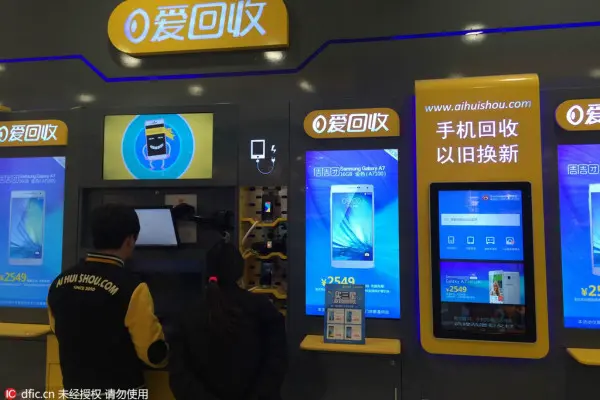Since the words "new economy" were put into a government report, by Premier Li Keqiang, for the first time on March 5 during the two sessions, it has become the focus of social attention.
According to a report released by Ali Research, the Alibaba Group's research arm, there are ten most important issues around the topic of new economy.
- New infrastructure: cloud, internet, terminals
New cloud computing technologies are unveiled on the computing conference held by Alibaba Group's cloud computing arm Aliyun in Hangzhou, Zhejiang province, October 14, 2015. Photo by: IC
Being added to the existing agricultural and industrial infrastructure, new infrastructure is playing an increasingly important role.
It includes three parts: the bullish breakthroughs on cloud computing and big data infrastructure; the rapid penetration of Internet and Internet of Things (IoT); and the mushrooming of smart terminals and applications.
- New element: data
A screen showing big data analysis on display at the stand of China Telecom during the 2016 Mobile World Congress (MWC) in Shanghai, June 29, 2016.
Data, the core production element in the era of information economy, can be shared and its use is increasing. It also boasts hybridity and immediacy.
It is gradually replacing the original scarce resources and boosting productivity, such as in the labor force and capital.
As big data can restore the objective world, data can create a new physical world that integrates virtuality with physics. And the cross-boundary convergence of data will derive new sectors of data service and achieve new economic growth.
- New structure: mass collaboration
An employee of Stupid Girl's Farm shows the company's online shop in front of the strawberries they grow in Handan, Hebei province, December 26, 2014.
Mass collaboration includes network collaboration, crowdsourcing cooperation and organizational innovation.
Supported by the new infrastructure of internet and cloud computing, mass and socialized collaboration means labor division under the premise of collaboration.
The boom in the e-commerce services sector is the fruit of mass collaboration. And e-businessmen groups are a typical case of mass collaboration.
- New business model: Consumer to Business (C2B)
A worker at Aihuishou.com, China's first C2B electronic products bidding recycling platform, shows a customer how to use the machine at the company's recycling point at a mall in Beijing, February 29, 2016.
Today's internet, cloud computing and big data are constructing a set of brand new business systems, and a new C2B business model is emerging.
While China's most traditional companies are still struggling offline and most online companies are at the destocking stage, some companies that have already tried C2B are demonstrating totally different management models and company performances.
The C2B model is growing in a large-scale.
- New organization model: cloud system
A commuter shows the Didi Chuxing app on her iPhone in Beijing, May 13, 2016.
The evolution of organizations in the future will go in three directions: large connection, great division of labor and mass collaboration.
Cloud system refers to the static structure of "platform plus front-end" and the dynamic process of network operating. For example, the operation of China's largest ride-hailing application Didi Chuxing is based on a large number of drivers and passengers, which makes its organizational structure a cloud system.
The process of organization will become self-organized and the boundary of organization will be open.
- Platform economy
"Papi", a graduate of the Central Academy of Drama, became popular online in a short time and has secured a $2m investment. Photo by Wei Xiaohao/China Daily
As an important social, economic and organizational phenomenon, platform economy is the basis of sharing and ecology. The combination of giant platform and mass small front-end constitutes the dividing and cooperation system in the information era.
- Free connector
A graduate works in an e-commerce company in Xi Ao village, Yongjia county, Zhejiang province, September 10, 2014.
As a platform's emergence significantly lowers the threshold of innovation and entrepreneurship and internet stimulates the vitality of the personalized market and grassroots entrepreneurship, small businesses, entrepreneurs and consumers are becoming free connectors.
- Micro Finance
An advertisement for the Shanghai Pudong Development Bank's small business is presented in Shanghai, June 22, 2016. [Photo/IC]
Technology innovation has promoted the development of micro finance. And the combination of internet and finance has reduced the costs of information searching and trading and reshaped the financial service's model and function.
Micro finance can serve small and micro businesses and promote inclusive finance among online finance consumers.
- Cross-border economy
Workers sort out imported goods at the Hangzhou Cross-Border E-Commerce Industrial Park in Hangzhou, Zhejiang Province, November 10, 2015. [Photo/ Xinhua]
While the cross-border economy has huge development potential, it is facing increasing competitions of dominance on rules.
The new engines of cross-border economy include shortening the supply chain and enhancing competiveness, and promoting the upgrading and transformation of traditional sectors.
In addition, developing cross-border e-commerce trade service ecology and establishing a global online credit system are the new sector formats of cross-border economy.
It also opens new windows of promoting reform and opening up in the new period and assisting "the Belt and Road" and the Internet.
- Internet governance
Gordon Smith, vice president of Global Commission on Internet Governance, discusses cyberspace governance with other attendees at the second World Internet Conference in Wuzhen, Zhejiang province, December 18, 2015. [Photo/IC]
Internet governance refers to ecological and multi collaborative governance.
(CHINA DAILY)
 简体中文
简体中文



